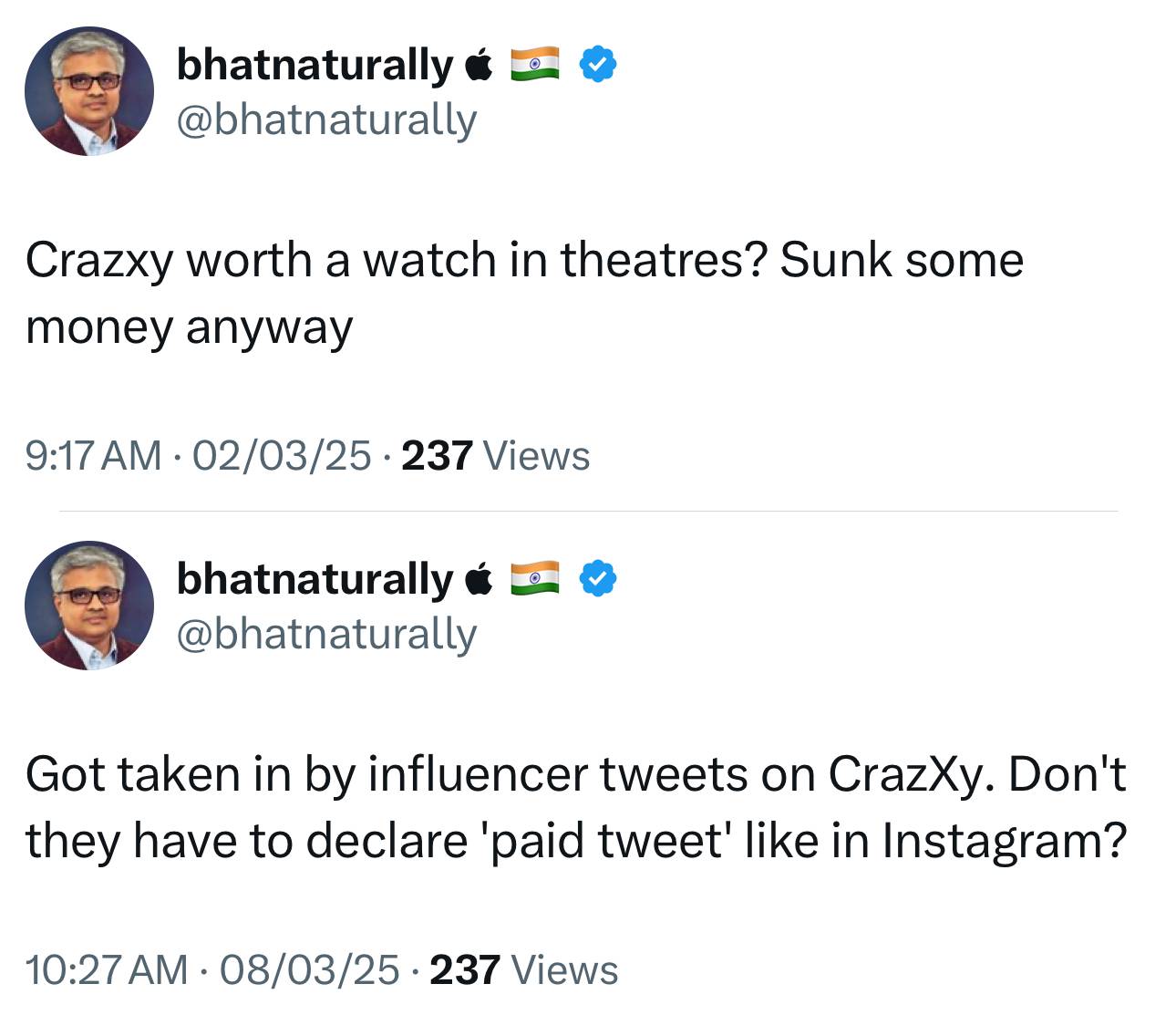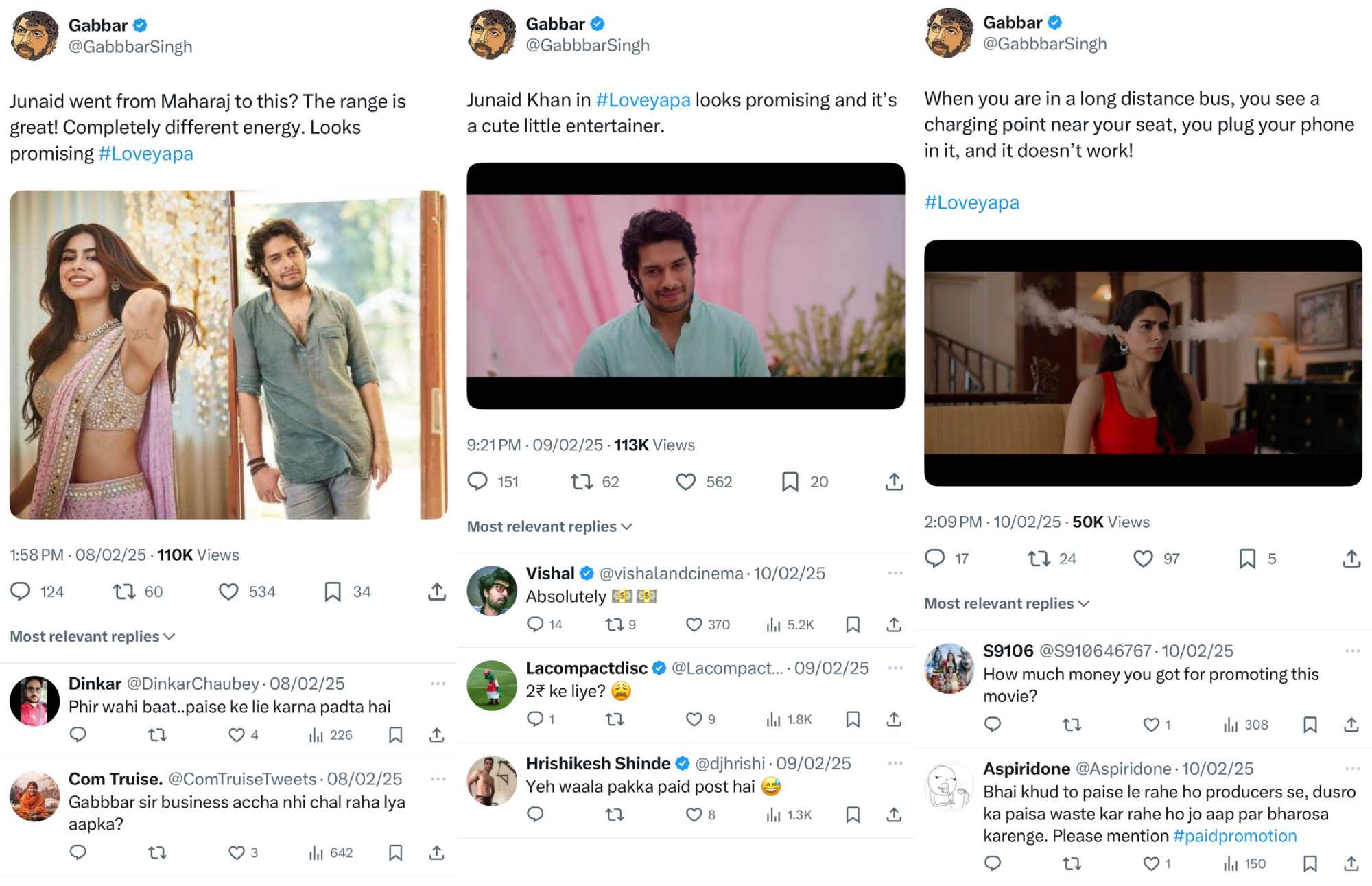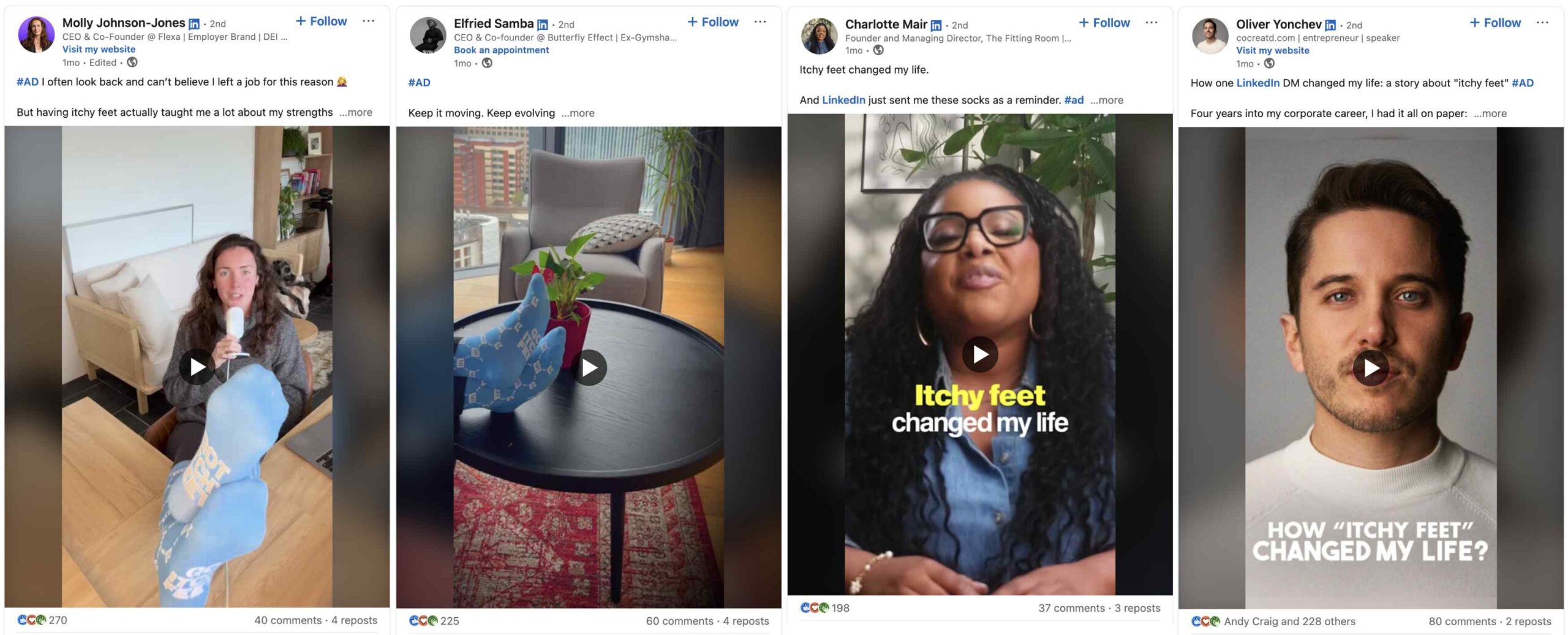
A company spends money and effort creating ad campaigns, either on TV, online or in print. And it spends money on media, to make sure that the ads are seen by relevant people. Should the same company also spend money in promoting the careers of the marketing team, so that fellow marketing professionals praise the ad campaign (not the company’s product or service that is being advertised, remember)? Common sense dictates that this shouldn’t happen. Because it would seem like an ad for an ad.
But this is precisely what is playing on LinkedIn for many, many campaigns these days, starring LinkedIn’s so-called ‘influencers’!
To explain this odd turn of events, allow me to set some context.
—
It was first, “Crazxy worth a watch in theatres? Sunk some money anyway”. Six days later, it was, “Got taken in by influencer tweets on CrazXy. Don’t they have to declare ‘paid tweet’ like in Instagram?”!

Quite a few influencers were crazxily and relentlessly tweeting about the movie in the run up to its release.
Pre-release

Songs

Post-release

So, it is understandable when we see the disappointed tone in ‘Got taken in by…’. It was hype via paid influencers (who did not disclose that they were simply tweeting as per a contract and not because they genuinely liked, or even seen, the product they are excited about).
Many other movies are being pushed too, including hilariously positive tweets on movies that have otherwise bombed!


These influencers are not professional movie reviewers. So, expecting objective or deep analysis of new movies from them is unfair.
On a related note, there was an actual report on how paid reviews are killing the movie industry recently: Bollywood’s dirty secret: Paid reviews that are killing the industry.
In a way, all these influencers bring to the product (here, a movie) is visibility. This is not different from the makers of CrazXy releasing an ad in The Times of India. But there IS a difference, however – when we see the print ad, we know it is an ad and discount its pitch. When we see someone we follow on a social platform go ga-ga over the same product, and there is no disclosure that it is a paid tweet and not a personal opinion, it is easy to trust the endorsement and take decisions based on that. If there was a disclosure, we’d be ready to discount the excited tone, just like we do with a print ad.
The trouble is that this kind of behavior is not restricted to Twitter/X alone anymore. A far more insidious and invasive version of this is playing now on LinkedIn, a professional platform.
The game on LinkedIn has a very different goal. It is also amusingly silly.
Unlike movies or products, what gets promoted excitedly on LinkedIn are promotions – ads for products or services! The irony of this is telling: advertisements are supposed convince people to consider those products or services (being advertised). But here we have people getting paid to promote the ads themselves, and not the actual products or services those ads pitch to end users!
Here’s an example of the LinkedIn equivalent of ‘Got taken in by influencer tweets on CrazXy’:

“All my industry people, who have been raving about the Behrouz billboard” and “I’m shocked to see some of the coolest minds on LinkedIn praising it” – and this, despite many influencers on LinkedIn having posted it under the horribly misleading ‘Brand Partnership’ tag and many who have not used any tag at all, either via LinkedIn or as per ASCI guidelines.
Here are the many, many LinkedIn posts on the Behrouz Biryani billboard. It started with some branded partnership posts and because a lot of people saw those posts, other started posting out of FOMO.




What is particularly interesting in this ‘Emperor’s new clothes’ style post by Vineeta is not the surprise that many people have been raving about a billboard, but ‘some of the coolest minds on LinkedIn praising it’.
It’s not just the Behrouz Biryani billboard. Here’s a similar engineered campaign for Daawat’s print ad.

Or one about a print ad by Xiaomi.

If you notice Shitiz’s post above, it says, ‘My feed today is flooded with Xiaomi India print ads. No marks for guessing why it’s grabbing so much attention’. Why wouldn’t it, if Xiaomi’s influencer marketing agency has paid so many people to write about it and create an illusion as if it is ‘grabbing so much attention’?
It leads me to a simple question: what do these people who raved about the ads really think about it? That is, did they really think it was an innovative billboard/print ad brimming with creativity, or did they say that on LinkedIn ONLY because they were paid to do so?
Now, if such hyperbole was shared by young IT professionals or college students, I can totally understand. But if a billboard or a functional ad was being endorsed as massive creativity by marketing professionals—for a fee, of course—what does it really say about such marketing professionals’ credibility? This comes close to the paid movie reviewers news I shared earlier in this post!
Think about this logically: these marketing professionals who share their views on the marketing industry, about their child’s shenanigans, their parents’ struggle with money, their ex-bosses working style, their office wins, promotions, etc. suddenly rave about an ordinary billboard or a print ad and mount it as some hugely innovative example of creativity. The crutch: It is ‘Brand Partnership’. Isn’t that similar to a movie reviewer raving about a decidedly sub-standard movie just because he has been paid by the producer to do so?
Why would otherwise sane professionals pollute their credibility—and their professional timeline on LinkedIn—by taking the value of their endorsements so casually? If the answer to that is ‘a few thousand rupees’, I get that. But they also need to remember that the internet (and social media platforms) shows only a snapshot of vocal, visible people online. There is a much larger set of people who do not participate online and only lurk. This considerably larger set of people see the kind of endorsements you provide under ‘brand partnership’, notice how clickbait’ish it sounds (you say it is great, but it really isn’t) and leave thinking how poorly you treat your own word just for a few thousand rupees.
Is your professional opinion so cheap (or ‘affordable’ in marketing parlance) that you would vouch for an ordinary campaign for just money?
In this process, the same marketing professionals also depend on the ambiguity of whether a content is paid for or not. How? By using LinkedIn’s mighty evasive ‘promotional tag’ (that gets appended to the bio) and by hiding ‘ad’ or ‘collab’ among other hashtags at the bottom. It makes it all the more obvious that even they are 100% sure that if they started the post with a honest disclosure like, ‘This is a paid advertisement’, no one would take it seriously. Crux: these influencers DEPEND on people assuming that it is an organic point of view. If they found out eventually/later that it was paid-for, that’s ok – but they want to provide bang for the influencer marketing agency first. Personal credibility and endorsement can take a hike.
If, for instance, they started the post boldly and honestly with, ‘This is a sponsored post in association with Behrouz Biryani’ and then go on to write a very entertaining and interesting to read post, with cross-referenced examples, historical context, and/or other relevant background details, then such content will be useful despite the first sentence.
This is not rocket science at all. And other kinds of content creators have done this for a long time. Consider the kind of sponsored content shared by influencers like Shraddha Jain or Danish Sait on Instagram. We watch and enjoy those sponsored content even after knowing that it is paid for content!
Why? Because they make a damn good effort to create even sponsored content into enjoyable pieces of content.
Marketing professionals can absolutely do this too. But it would take effort. A lot more effort than simply writing 3 paragraphs of false effusive praise about a largely pointless billboard that gets talked about only because the company lavished money on LinkedIn influencers to get it talked about.
The amusing and ironic fact here is how it all sounds like an ad campaign for the career enhancement of the marketing team of the client brands!
These influencers are praising an ad campaign. They are not talking about the product or service itself. This means they are saying that the marketing team did a great job!
That literally means the marketing team is spending the company’s money to promote the ad campaign, whereas they should be spending that money to promote the product or the service of the company. In crude terms, the marketing team is spending the company’s money to boost their careers! I’m not sure how the CEOs of these companies are ok with this bizarre phenomenon.
As far as clear disclosures go, consider what LinkedIn did for its own campaign titled ‘Itchy Feet’ in the UK, in February 2025. It officially worked with a few ‘Top Voice’ profiles from the UK and you would notice that all of them start their post with “#AD” in the first or second line! Why first or second line? Because it would show up even if you are seeing these posts on your timeline (and not going to the post itself). This is LinkedIn’s own influencer outreach, remember! LinkedIn, the platform, clearly wants the influencers it works with to be totally open about paid endorsements.

I presume LinkedIn is yet to launch ‘Brand Partnerhip’ in the UK since none of the top voices have used it. Would these people drop the #AD disclosure on the top of their posts after the launch? I don’t know, but it is something worth looking out for.
